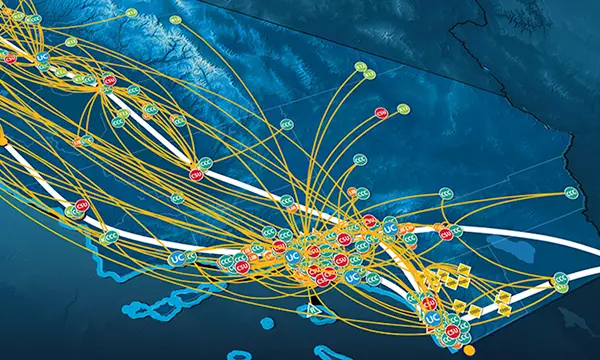- About
- Network
- Community
- Initiatives
- News
- Events
- Blog
- Publications

CENIC Network Automation Update: New Network-Source-of-Truth Tool Implemented
Categories RENS & NRENS
Tags automation
Led by California's research and education community, network-enabled innovations like artificial intelligence, machine learning, and big-data science are reshaping the world before our eyes. To support that community, CENIC’s California Research and Education Network (CalREN) must also keep pace with them, anticipating and responding to the unique needs of that community quickly, efficiently, and sustainably.
CENIC manages space in 61 colocation facilities across California. Within each colocation facility, CENIC engineers must be able to accurately document our physical infrastructure and other important information for all CENIC engineering teams and share this information with various automation platforms. These requirements create a strong need for a Data Center Infrastructure Management (DCIM) system and/or a Network Source of Truth (NSoT).
CENIC’s Network Source of Truth Model
While the two concepts have similarities, DCIM is often referred to as a ‘best effort’ documentation tool (manually updated after network changes), with the most accurate data (i.e., “the source of truth”) being the network itself. With an NSoT, this concept is reversed. For CENIC, this means when engineers plan network changes, they make changes to our NSoT tool first before even touching device configuration lines. This data is then retrieved by other CENIC automation tools when provisioning new services programmatically.
Especially with a large network such as CENIC’s that is constantly evolving, an NSoT must model a wide variety of data, including devices and device types, site/location/rack information, power usage and configuration, IP addressing, VLAN/Route Target/etc. tracking, patch panels, and device cabling usage. It must also create ad hoc reports, such as devices per physical site or port usage data, and perform many other functions while making this data available through industry-standard REST or GraphQL APIs.
Unique Features of Netbox Make It Right for CENIC
CENIC has evaluated and worked with various DCIM platforms to meet this need and concluded that NetBox was the best fit for its environment as the NSoT. Features such as multi-termination cabling, custom field validation, modules (allowing for more accurate modeling of modular devices), UI customization features such as user dashboards, better cable modeling, more flexible rack mounting, and event rules will allow network engineers to model CalREN with a high degree of accuracy. This information will then be available to other CENIC tools and systems, reducing duplication of information and further increasing data accuracy. This flexibility is critical for CENIC’s large and dynamic network.
“Over the past year, CENIC has completed upgrading six out of seven major backbone node sites to support native 400 Gbps handoffs from member institutions, with the final site to be completed in July,” said Josh Dickman, CENIC Associate Director of Network Services. “This required migrating around 500 associate circuits to new Juniper MX10008 routers in about six months while also continuing to provision new circuits. NetBox allowed us to accurately model and plan each service ahead of migration (or deployment), which simplified planning efforts, reduced errors, and allowed for exporting to other data systems. NetBox will also allow us to accurately answer questions about existing services going forward, such as power delivery, cross connects, port usage, and more.”
A Seamless Cloud Solution
To deploy NetBox, CENIC chose to partner with NetBox Labs to deploy their NetBox Cloud product. This SaaS solution allows CENIC systems engineers to focus on developing and maintaining infrastructure for its more customized solutions such as Cobber, while NetBox Labs manages hosting, backups, and upgrades of NetBox.
As CENIC continues to upgrade and improve the network, our engineers will look to programmatically share data between NetBox Cloud and other automation tools, including CENIC’s own Cobber, Cisco’s Network Services Orchestrator (NSO), and others. This is integral to CENIC's Network Configuration Management system, allowing CENIC’s engineering team to drive automation, efficiency, increase security, and provide the future-facing network and services each of CENIC’s member institutions needs.
Learn more about CENIC’s approach to Network Configuration Management here.
Related blog posts
The Big Game Is Big Data: How CENIC and the California Research and Education Network Support Member Athletics
When Fresno State needed to connect to Pac-12 Enterprises to broadcast a live football game over CBS, the Chancellor's Office reached out to CENIC for what Pac-12 later called the smoothest turn-up they've ever experienced.
Enabling Network-Based Collaboration Around the World: A Tour of CENIC and Partner Network Maps
On the Network Maps page at the CENIC website, you’ll find maps of all the networks, peering facilities, and exchanges to which CalREN connects, showing how thousands of CENIC member institutions connect to CalREN and to colleagues all over the globe.


